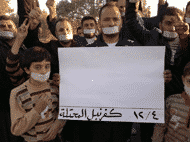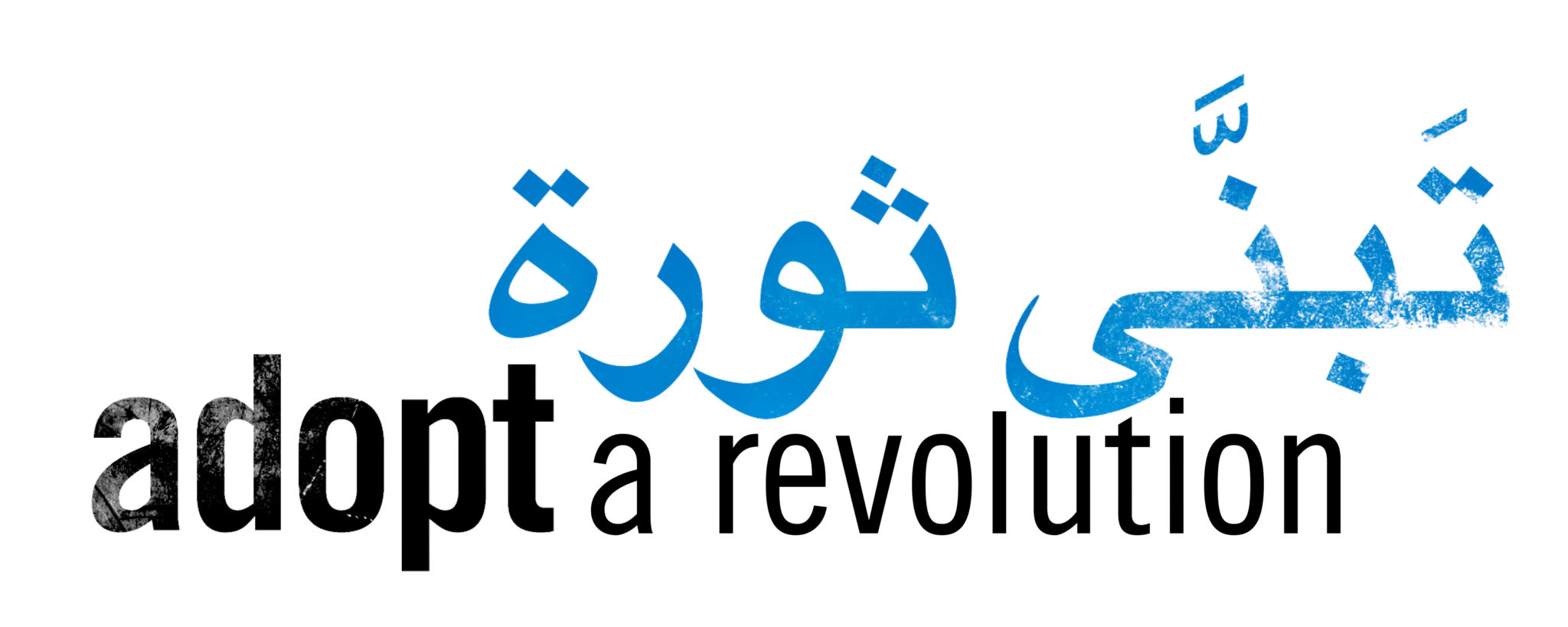
The city of Homs in all its neighborhoods still suffers from a suffocating siege and heavy continuous security campaigns that are resulting with tens of casualties and wounded every day. This is why it deserves to be declared as a crisis zone. The city is still under 6 months of a military and security invasion where horrifying crimes and abuses have been committed, including random shelling for homes and neighborhoods, sniping, killing under torture, and abusing dead bodies.
In the same time, the city continued to peacefully demonstrate in all neighborhoods, protected by the Free Syrian Army which has recently started to peacefully protected demonstrators, using the light weapons they possess, by standing up to security forces and the regime’s army and Shabiha (thugs) when they confronted demonstrators and invaded neighborhoods and towns.
The regime has relentlessly tried to ignite sectarian feuds between the city’s neighborhoods. These neighborhoods are inhibited by Syrians from all sects and religions.
Homs is located in the center of Syria, and is a transportation node that connects many provinces and areas in Syria. It is also deeply connected with all other Syrian cities: socially, economically, and culturally.
The urban structure of the city has expanded in the last decades after migration from the countryside of Homs to the city. This connected its urban core with nearby suburbs and towns, creating one urban body that extends over a large piece of land. Alongside its growing economical, cultural and human position, Homs reflects the Syrian human composition in all its sects, religions, ethnicities and intellectual trends.
Homs is Syria in a smaller scale; a visitor to any street or alley can identify dialects, facial features and looks from all over Syria. Homs is the amalgamation of the national Syria identity combined: urban, country, and Bedouin. Muslims in Homs are Sunni, Alowite, Shiaa, Ismaelians and Drouze. Christian in Homs are Orthodox and Catholics. The city also has Kurds, Armenians, Sarkissians and Turkmans.
Since the beginning of the revolution, the regime played its usual card in turning a political conflict into a social divide, so they targeted the human structure of Homs as a city and as a model. Homs was their first target to neutralize the revolution and turn it into a civil fraction among the people who lived in adjacent streets and neighborhoods.
Activist Omar Idlibi see that “the efforts of the regime to start a sectarian fight in Homs started in March 25th when they sent off a pro-regime crowd chanting sectarian slogans and beating a demonstration that took off on that Friday (Friday of Dignity). These acts escalated by using Shabiha from loyalist neighborhoods with an Alawite majority to attack the demonstrating neighborhoods, and by Security Forces’ resort to kidnapping, killing, and delivering the kidnapped to the Shabiha to kill and abuse them.”
If there were any sectarian incidents in Homs in the previous periods, they were isolated individual incidents that were contained by the people most of the times.
The last month witnessed a considerable increase in those incidents, noticeable mainly in acts of kidnapping and some reverse kidnapping. Those acts were mainly against taxi and bus drivers, conducted by security forces and Shabiha, or by security patrols and checkpoint that would in turn deliver them to thugs. These acts were mainly to trade for others already kidnapped, or for a ransom.
“Kidnapping based on ID cards on security checkpoints became a familiar act”, says an activist in Homs. He continues: “we are kidnapped in front of security air force division and national security agents, in many cases it is them who would kidnap and deliver the person to the Shabiha”.
What validates the theory of security forces being involved in acts of kidnapping is that delivering the kidnapped person after successful negotiation is done through security agents and even sometimes in security divisions, as reported by eyewitnesses. “This has become an important source of income for them to finance their Shabiha and support the lack of funds they are suffering from. Sometimes the ransom they ask for is too high”, one of the activists says.
Most of those thugs are known by name and have “their armed groups” that are responsible for getting the job done. Among them are: Shehadeh Kamel Mayhoub, Wael Mulhem and Firas Hadbeh. They are parliament members.
In many other cases, if there was no intention to trade them for other kidnapped or for a ransom, the kidnapped are taken to mainly-loyalist neighborhoods like Alzahraa and Alnizha, where they are beaten and humiliated publically before they are released. These acts, repeated in other cities like Banyas, aim at creating sectarian tension between different neighborhoods.
In other cases, these acts had tragic results were bodies of the kidnapped were found thrown away with signs of torture and abuse by the hands of security forces and Shabiha. There are no exact, or approximate, numbers for the kidnapped from both sides, most of them are not declared rather dealt with through intermediates.
What’s interesting to observes is that contradicting tales are not limited to the day of the incident, they continue until the moment of writing this report, where the same story was different from one person to another in the same neighborhood, or even between different
neighborhoods.
This proves that the war of rumors and attempts to start sectarian tension were the main goal for what happened, and not a result for it.
The points we could match between all different tales are:
- Some stories were reported to have happened in loyalist and demonstrating neighborhoods in similar ways. This can be shown by the story of the 34 killed people. They were reported in the exact same details in both loyalist and demonstrating neighborhoods, which means that what’s happened that day was mostly to cause fear and turn neighborhoods against each other.
- Many of the details that circulated that day on facebook pages and websites were proven completely untrue, and were mostly feeding sectarian tension and fueling the feud between different neighborhoods (like nailing loyalists to a cross on the door of a mosque, or dancing on the bodies of demonstrators).
- Until this moment, there are no exact numbers for casualties from both sides, and no agreement on the stories about the kidnapping dates of those who were killed, and where they were killed.
- Shelling one of the mosques in the migrants’ neighborhoods and setting many parts of it on fire by the armed groups of the PM Wael Mulhem. This played a major role in creating a lot of tension in the demonstrating neighborhoods, and caused some angry reactions where some of the young men in these neighborhoods attacked loyalist neighborhoods. This resulted with an exchange of random and heavy fire, which spread to many neighborhoods of the city.
- In the same day, there was an invasion to many of the demonstrating neighborhoods like Alkhlidiyeh, Jouret Alshayah, and Bab Tadmor. Many of activists were detained, and many others killed. Young men of these neighborhoods kidnapped one of the Shabiha, Samer Al-Ahmad, in return. When loyalist neighborhoods knew, they attacked busses and
kidnapped 6 women from the demonstrating neighborhoods. Negotiations took place later and the Shabeeh was released in exchange for the freedom of the 6 women. - That day, the army set 8 shops on fire in Karm Alzaytoun area in retaliation to kidnapping that Shabeeh. Also, one of the detainees from the demonstrating neighborhoods was brought in a car trunk to Alzahraa neighborhoods, and then they took him out of the trunk to beat and abuse him in front of the people. Then they brought 7 other Bedouins, took off their clothes and beat them relentlessly while insulting and abusing them before they were released.
- All of those criminal and provocative acts, which all happened in the same day, are clearly planned for an obvious reason: heavy and random shooting in all city neighborhoods.
- It’s worth mentioning that Alzahraa neighborhood is fully armed by the regime since the beginning of the revolution. “Even water tanks exploded after young men in the neighborhood opened fire on rooftops” says an activist from that neighborhood.
- Many of the activists and eye-witnesses think that many of the bodies belonged to kidnapped people who were killed and then thrown in the streets to fuel the fight among neighborhoods that day.
Names of martyrs of the sectarian events of that day, that could be documented so far, are:
- Nasser Hammoud Shourtani
- Samer Hammoud Shourtani
- Tawfic Hammoud Shourtani
- Qasem Hammoud Shourtani
- Ahmad Hammoud Shourtani
- Samir Mohammad Shourtani
- Ahmad Mohammad Shourtani
- Hassan Mohammad Shourtani

